Menus
- Sports cannon through and through
- Increase in torque by 15 percent
- The sensor box and ABS come from Bosch
- Ducati 1299 Panigale S hangs fine on the gas
- Adjustable steering damper is electronically monitored
- Armed to face the competition
- Technical data Ducati 1299 Panigale S
- What’s new?
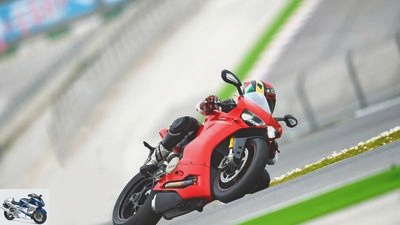
Ducati
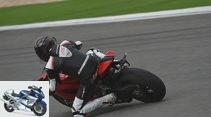
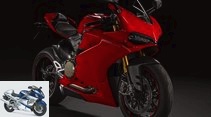
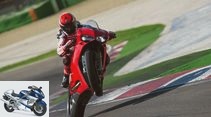
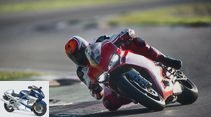
26th photos
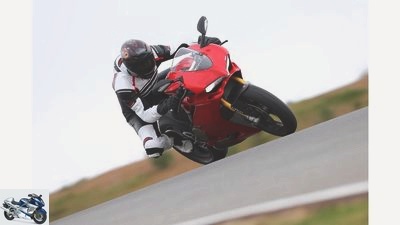
Ducati
1/26
Ducati 1299 Panigale S..
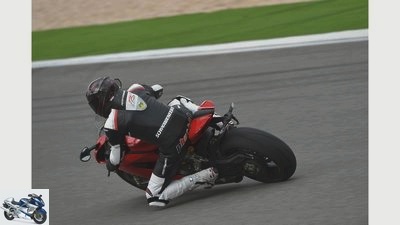
Ducati
2/26
Ducati 1299 Panigale S..
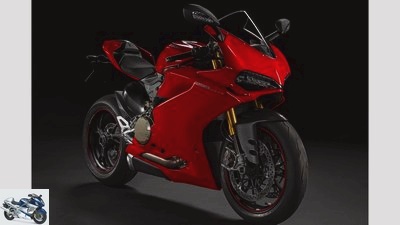
Ducati
3/26
Ducati 1299 Panigale S..

Ducati
4/26
Ducati 1299 Panigale S..
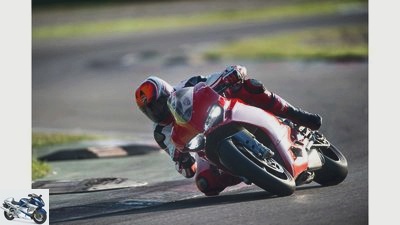
Ducati
5/26
Ducati 1299 Panigale S..
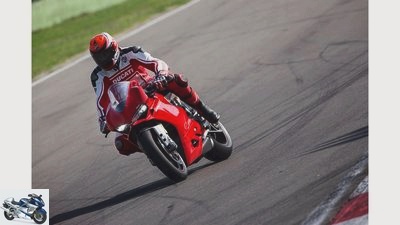
Ducati
6/26
Ducati 1299 Panigale S..

Ducati
7/26
Ducati 1299 Panigale S..
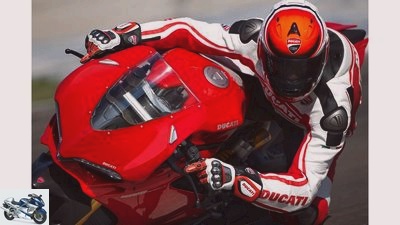
Ducati
8/26
Ducati 1299 Panigale S..
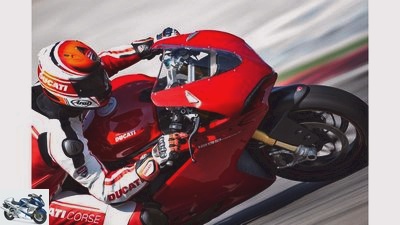
Ducati
9/26
Ducati 1299 Panigale S..
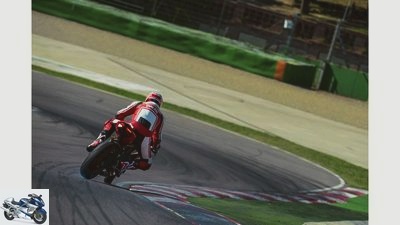
Ducati
10/26
Ducati 1299 Panigale S..
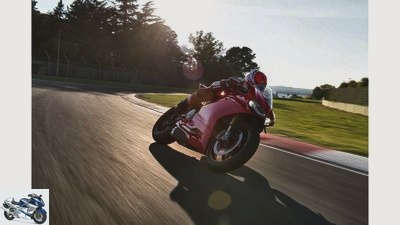
Ducati
11/26
Ducati 1299 Panigale S..
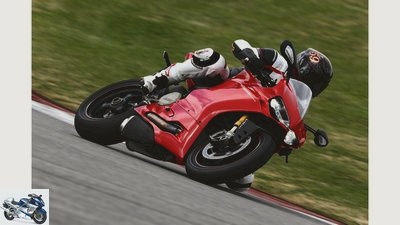
Ducati
12/26
Ducati 1299 Panigale S..
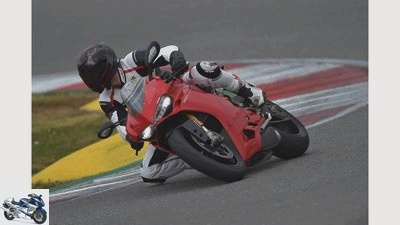
Ducati
13/26
Ducati 1299 Panigale S..
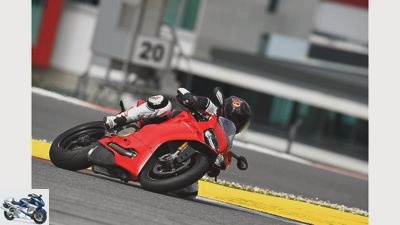
Ducati
14/26
Ducati 1299 Panigale S..
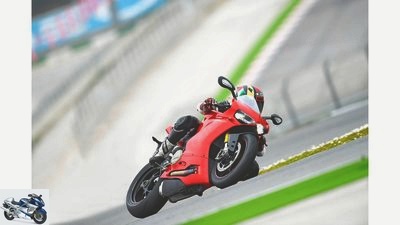
Ducati
15/26
The Ducati 1299 Panigale S does not care about displacement limits, but is only committed to driving dynamics.
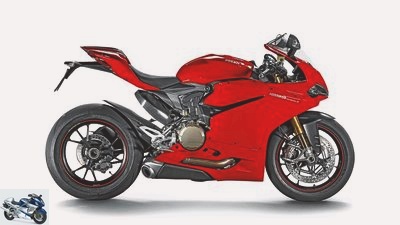
Ducati
16/26
The heat protection of the manifold under the seat now seems to work more effectively, the rear and fairing have been redesigned, forged wheels only have the “S”.
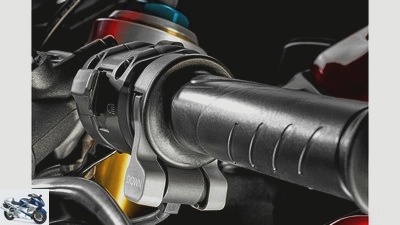
Ducati
17/26
Shift paddles of the Superleggera for engine braking, traction and wheelie control.
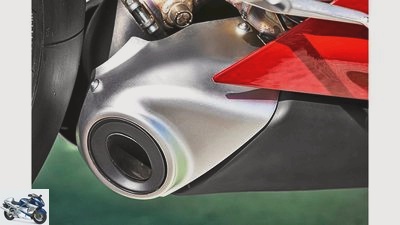
Ducati
18/26
Thicker manifolds and new mufflers make it easier for the 1285 to breathe out.
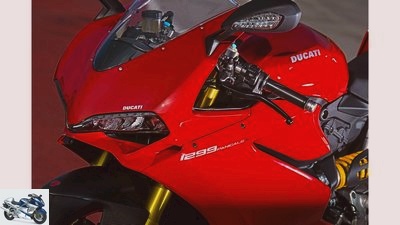
Ducati
19/26
Larger air inlets under the LED headlights, the small round one is only used for optics.
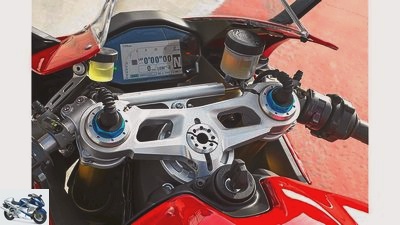
Ducati
20/26
In addition to the spring elements, the steering damper is now also electronically controlled.
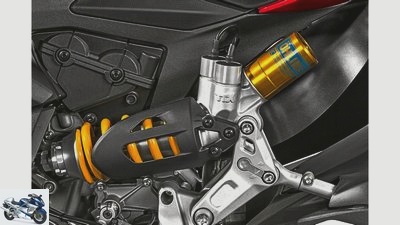
Ducati
21/26
The shock absorber got a new set-up and now works a little more comfortably.
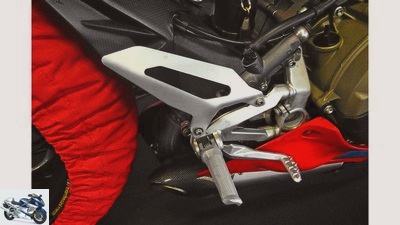
happiness
22/26
A good 20 years after the 916, there are now milled, grippier notches ex works for the first time.
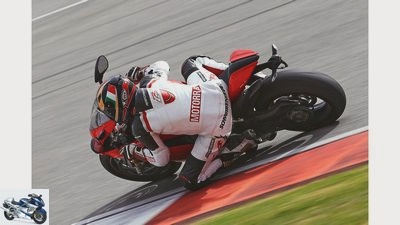
Ducati
23/26
The Ducati 1299 Panigale S has become a very active motorcycle and has increased drivability.
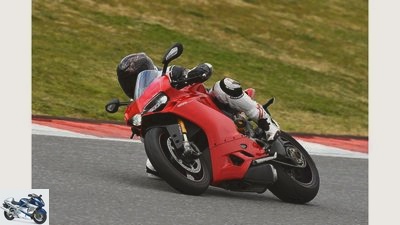
Ducati
24/26
Ducati 1299 Panigale S..
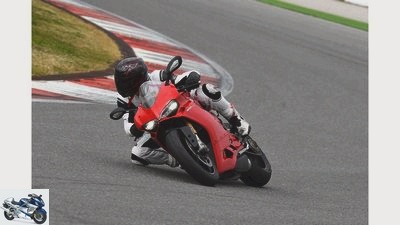
Ducati
25/26
Ducati 1299 Panigale S..
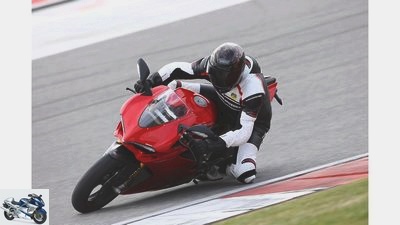
Ducati
26/26
Ducati 1299 Panigale S..
Ducati 1299 Panigale S in the driving report
Sports cannon through and through
For the first time, Ducati breaks the chains of the relevant racing regulations with its super sports bikes. The Ducati 1299 Panigale S does not care about displacement limits, but is only committed to driving dynamics. Pressure in all positions is the order of the day. Flanked by the latest electronics, including for the chassis.
Ducati is always good for a surprise. After the uncompromisingly extreme Superleggera, the charming, retro-styled Scrambler in particular caused a stir. In their slipstream, a new variant of the sports flagship Panigale matured almost incidentally in the halls in Borgo Panigale. To the surprise of many with a displacement of 1299 cm³. And thus outside of the usual racing regulations. Ducati still has the Panigale 1199 R ready for those who want to fight for honor, points and placements in superbike races. Nevertheless, that too D.ucati 1299 Panigale S Sports cannon through and through.
Buy complete article
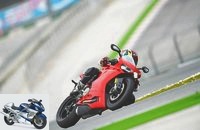
Ducati 1299 Panigale S in the driving report
Sports cannon through and through
1299 Panigale S neatly lined up in the pit lane of the Portimão racetrack. At first glance, it doesn’t seem that much different from the 1199. Well, the windshield is 20 millimeters higher, the intake openings in the fairing slightly larger, the rear has been redesigned. So all the hoopla just because of the 100 cm³ drilling? Slowly. The Ducati still has a few surprises in store.
Increase in torque by 15 percent
The already huge bore of the Superquattro-V2 grew from 112 mm to an almost unbelievable 116 mm. Forged pistons as big as saucers, just high enough to accommodate the three piston rings, now race up and down through the cylinders. But the Ducati engineers had less of the resulting 100 cc more and the peak performance, which has grown from 195 to a huge 205, in view – which is of course gladly taken with you. The main focus was on increasing the torque. According to project manager Cristian Gasparri, it has been increased by 15 percent and, above all, the important range from 5 to 8,000 rpm has been strengthened. Exactly the area in which many complained about the Panigale’s lack of pulling power. In addition, the Ducati 1299 Panigale S competes with a refined chassis geometry, based on the experience of the superbike teams. The adjustable swing arm pivot is fixed four millimeters lower, which provides more grip when accelerating. Because this is associated with minor compromises in handling, the fork on the 1299 is now half a degree steeper at 66 degrees in order to inspire turning and maneuverability together with the caster that has been shortened by 4 to 96 mm.
Above all, Ducati has increased the arsenal of electronic helpers properly. In addition to the previously known three driving modes Rain, Sport and Race, the Ducati 1299 Panigale S now also has cornering ABS, an eight-stage wheelie control and an automatic gearshift that also enables downshifting without the clutch. This so-called blipper is also fed information by a sensor on the shift drum. There is also the shift paddle on the left handlebars introduced on the Superleggera to change the engine brake, traction or wheelie control while driving in race mode. The only thing missing is launch control.
All articles about the Ducati 1299 Panigale
The sensor box and ABS come from Bosch
The S version, which is more noble than the basic version – which was available during the test – is also adorned with light forged wheels and Ohlins spring elements. Previously they could be adjusted electrically, but the Ducati 1299 Panigale S now has a semi-active chassis. However, the Ohlins technicians do not use spring travel sensors to change the damping depending on the wheel movements, as BMW does with the S 1000 RR. Rather, the electronics record acceleration, deceleration, lean angle as well as yaw and roll rates and thus change the damping depending on the driving situation. The sensor box for this, like the ABS, which is one kilo lighter, comes from Bosch.
And of course the chassis of the Ducati 1299 Panigale S can still be electronically adjusted to fixed damping values. Your fingers are itching to try it out on the track. Too bad that light drizzle always turns fast laps into a ride on the razor blade. But alarming is not an option. After all, the first cautious laps reveal that the rain mode may be an option on slippery country roads. On the other hand, on the racetrack with the power reduced to 120 hp and the traction control that intervenes very early on, not really. But the drizzle allows itself a break, whoops, switched to sport mode. Ah, now we’re moving forward.
Ducati 1299 Panigale S hangs fine on the gas
Portimão not only has blind peaks, compressions and terribly fast corners, but also hard braking zones and tight corners, from which you have to accelerate with force. And here the increased torque is immediately noticeable. Great, how the twin pulls out of the corners at medium revs, you catch yourself taking third instead of second gear in some places and saving yourself a shift. The Ducati 1299 Panigale S hangs on the gas, the traction control, if it has to intervene, goes to work gently, and on the hilltops, the wheelie control brings the front wheel back to the ground in good time.
And when the Brembo M50 pliers bite into the 330 mm discs at the end of the sloping home straight, the lift detection keeps the rear wheel firmly on the ground. The newly tuned suspension strut of the Ducati 1299 Panigale S works noticeably more comfortably, which should be particularly pleasing for rural road drivers. However, there is clear movement in the framework during rapid changes of direction and hard braking maneuvers. Time to choose the hardest of the five settings that the semi-active suspension has to offer? Ohlins technician Martin Lugnberg advises the race mode.
Adjustable steering damper is electronically monitored
The drizzle was kind enough to hold back, so I quickly switched to race mode. That means: no more cornering ABS and no ABS on the rear wheel, wheelie control reduced, throttle response very direct, the suspension set-up tight. And now the Panigale gets going like the fire department. Greedily clicks forward when turning the gas, hugs the curbs wonderfully in second-gear turns, and remains significantly calmer even when turning the gas quickly and anchoring hard. The grip on the rear wheel is enormous, but the Ducati 1299 Panigale S does not have to be forcefully forced onto the tight line when accelerating out.
Thanks to the strengthened middle, the Ducati 1299 Panigale S delivers a lot of flavor when entering the corner. The V2 turns up with force, only from 10,000 / min its anger subsides a little, because the 1199 seems a bit more energetic. But it is still a bit of a beast and can still fidget with the handlebars when accelerating on hilltops and the start-finish straight. Good to know that the adjustable steering damper is electronically monitored. It is also nice that the notches that have finally been milled offer proper grip in wet conditions and when changing lean angles quickly. The Duc does it effortlessly and smoothly.
Armed to face the competition
Race mode also means: wheelie control at the second sharpest level. The pilot is already a little challenged when, for example, on the home straight, the Ducati 1299 Panigale S makes a manikin at just under 250 on a knoll and a gust of wind reaches under the front wheel. Then concentration is required, especially since the braking zone comes with a good 290 things. With full force in the iron, the Duc remains unmoved and stable on course, downshifting without clutch works perfectly.
Although the Panigale is the most manoeuvrable Ducati superbike to date, riding it fast was quite an intense exercise. The Ducati 1299 Panigale S looks smoother, more polished and more sociable thanks to its more powerful torque and refined geometry. And no less brutal in terms of sheer performance. Equipped with an open Termignoni titanium system, as it was ready for a few laps, it delivers even crisper torque and response. Unfortunately, the pleasure didn’t last long. The drizzle returned and ended the day of testing. But initial contact has already shown that the 1299 Panigale S is prepared to face the competition.
Technical data Ducati 1299 Panigale S
Ducati
In addition to the previously known three driving modes Rain, Sport and Race, the Ducati 1299 Panigale S now also has cornering ABS, an eight-stage wheelie control and an automatic gearshift that also enables downshifting without the clutch.
Ducati 1299 Panigale S.
What’s new?
Ducati
The Ducati 1299 Panigale S has become a very active motorcycle and has increased drivability.
- engine Bore now 116 mm (previously 112), 1285 cm³ (1198 cm³), 205 HP at 10,500 / min (195 HP at 10,750 / min), torque 144 Nm at 8750 / min (132 Nm at 9000 / min), compression 12, 6: 1 (12.5: 1)
- landing gear Semi-active chassis, steering head angle 66 degrees (65.5 degrees), caster 96 mm (100 mm), swing arm pivot point 4 mm lower, electronically controlled steering damper
- electronics Bosch 9.1 MP-ABS / ME, wheelie control, automatic gearshift with down-shift function, rear wheel lift-off detection, lean ABS (not in racing mode), lean angle indicator in the display, automatic tire calibration, DDA + with GPS preparation
- miscellaneous Windshield 20 mm higher, rear and cladding redesigned, new seat upholstery, milled notches, larger air inlets
Related articles
-
Ducati 899 Panigale in the driving report
Cervetti 17th photos Ducati 1/17 Even with the front wheel still braked and at high speed, the Ducati 899 Panigale hits the path precisely into the…
-
Ducati 1299 Panigale S in the HP driving report
Ducati 26 pictures Ducati 1/26 Ducati 1299 Panigale S. Gluck 2/26 Ducati 1299 Panigale S. Gluck 3/26 Ducati 1299 Panigale S. Ducati 4/26 Ducati 1299 …
-
Comparison test BMW S 1000 RR, Ducati 1299 Panigale S and Yamaha YZF-R1
fact 46 photos fact 1/46 Yamaha YZF-R1. fact 2/46 BMW S 1000 RR. fact 3/46 The swing arm takes the wheel axle very far back – good for driving stability….
-
Ducati 1299 Panigale S and Kawasaki Ninja H2 in comparison test
31 pictures 1/31 Left in the picture 197 HP and 145 Nm (Ducati 1299 Panigale S), on the right there are 200 HP and 133 Nm (Kawasaki Ninja H2) ….
-
Ducati 899 Panigale in the PS driving report
Ducati 37 photos Ducati 1/37 Ducati 899 Panigale in the PS driving report. Ducati 2/37 Ducati 899 Panigale in the PS driving report. Ducati 3/37 Ducati…
-
Driving report Ducati ST4 S active vacationers The Ducati ST series is more committed to sport than any other sports tourer. The new ST4 S sets …
-
Euro 3 classic: Ducati 1299 Panigale
Ducati 26 pictures Ducati 1/26 Ducati 1299 Panigale S. Ducati 2/26 Ducati 1299 Panigale S. Ducati 3/26 Ducati 1299 Panigale S. Ducati 4/26 Ducati 1299 …
-
Ducati Panigale R in the driving report
Ducati 20 pictures Ducati 1/20 Technically, in terms of weight and price, the Panigale R lies between the Superleggera and the 1299 Panigale S. Ducati 2/20 …
-
Ducati 1299 Superleggera driving report
Ducati 35 pictures Ducati 1/35 Ducati 1299 Superleggera. Ducati 2/35 Ducati 1299 Superleggera. Ducati 3/35 At the zenith of its power, the …
-
Ducati 1299 Panigale S and Ducati 1199 S in comparison test
fact 29 pictures fact 1/29 The two sisters only look like identical twins at first glance … fact 2/29 wheelbase (1437 mm), seat height (830 mm) …